#First100Days Crash Course
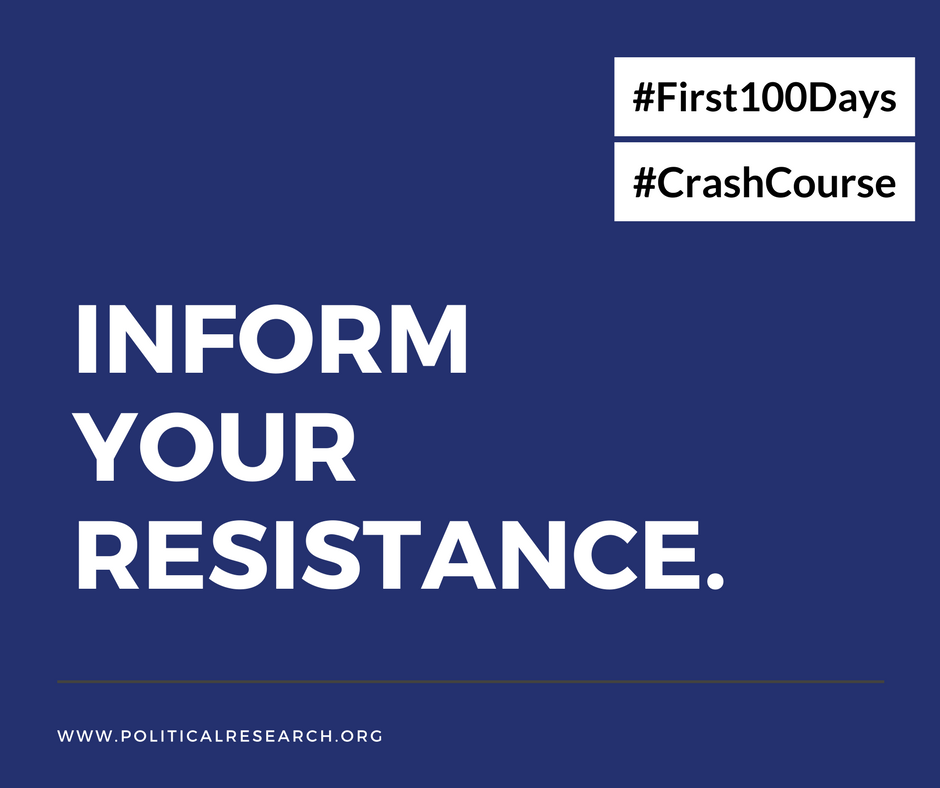
Introduction
Coinciding with Trump’s first 100 days in office — a period of time historically used as a benchmark to measure the potential of a new president — PRA shared readings, videos, and tools for organizing to inform our collective resistance based on principles for engaging the regime, defending human rights, and preventing authoritarianism. Weekly summaries are archived below and here are a few introductory readings:
- Drifting Right and Going Wrong: An Overview of the U.S. Political Right By Chip Berlet and Jean Hardisty
- Wrong About the Right by Jean Hardisty and Deepak Bhargava
- Ground Rules and Tips for Challenging the Right
- Sectors of the U.S. Right
- What time is it?: Why we can’t ignore the momentum of the Right by Scot Nakagawa and Tarso Luís Ramos
Week 1: The Alt Right
Featured excerpt:
Ctrl-Alt-Delete: The origins and ideology of the Alternative Right
Report by Matthew N. Lyons
The Alt Right helped Donald Trump get elected president, and Trump’s campaign put the Alt Right in the news. But the movement was active well before Trump announced his candidacy, and its relationship with Trump has been more complex and more qualified than many critics realize. The Alt Right is just one of multiple dangerous forces associated with Trump, but it’s the one that has attracted the greatest notoriety. However, it’s not accurate to argue, as many critics have, that “Alt Right” is just a deceptive code-phrase meant to hide the movement’s White supremacist or neonazi politics. This is a movement with its own story, and for those concerned about the seemingly sudden resurgence of far-right politics in the United States, it is a story worth exploring.
The Alt Right, short for “alternative right,” is a loosely organized far-right movement that shares a contempt for both liberal multiculturalism and mainstream conservatism; a belief that some people are inherently superior to others; a strong internet presence and embrace of specific elements of online culture; and a self-presentation as being new, hip, and irreverent. Based primarily in the United States, Alt Right ideology combines White nationalism, misogyny, antisemitism, and authoritarianism in various forms and in political styles ranging from intellectual argument to violent invective. White nationalism constitutes the movement’s center of gravity, but some Alt Rightists are more focused on reasserting male dominance or other forms of elitism rather than race. The Alt Right has little in the way of formal organization, but has used internet memes effectively to gain visibility, rally supporters, and target opponents. Most Alt Rightists have rallied behind Trump’s presidential bid, yet as a rule Alt Rightists regard the existing political system as hopeless and call for replacing the United States with one or more racially defined homelands.
Additional readings:
- Calling them “alt-right” helps us fight them by Matthew N Lyons
- Richard Spencer’s Mom Spins Victim Narrative for Self, While Neonazis Target Jews By Adele M. Stan
- Profile on the Right: Milo Yiannopoulos by Peter Montgomery
- More on the Alt Right will be continually added to our Portal Page HERE.
Week 2: Islamophobia & Antisemitism
Contemporary Islamophobia rests on a long history of conflict and it is important to to be aware of how Islam was seen in Europe over many centuries, because these tropes are the basis for most contemporary narratives. There are complex interactions among Islamophobic prejudice, discrimination, exclusion, and violence and it may be more accurate to discuss the topic as “Islamophobias” rather than as a single phenomenon.
Antisemitism is a durable and unique historic and contemporary form of prejudice or demonization appearing at various times based on perceptions of religion, ethnicity, and race. In the U.S., Christian supremacist notions created systems of oppression that kept Jews in a second-class status until after WWII. While institutionalized antisemitism as a form of oppression is no longer a major force, prejudice and demonization remain. Although Jews are actually a diverse ethnoreligious group, their biased critics often project on them a racial identity that has motivated intimidation and violence.
Media:
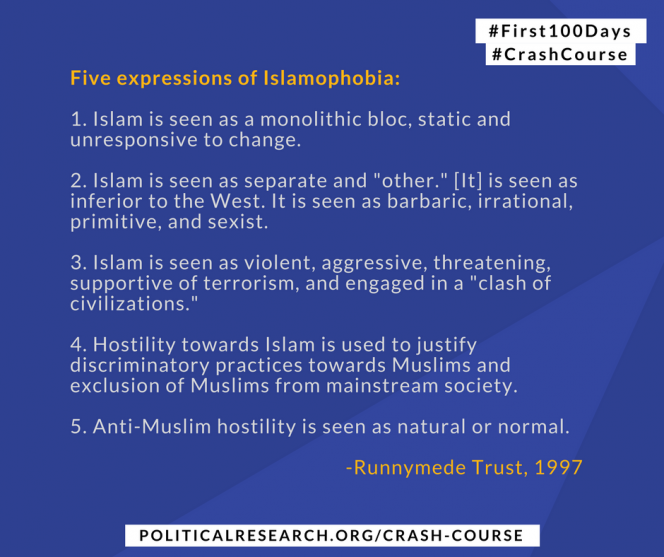
Featured resources:
- Pro-LGBTQ Smokescreens for Anti-Muslim Attacks by Cole Parke
- Richard Spencer’s Mom Spins Victim Narrative for Self, While Neonazis Target Jews by Adele M. Stan
- Terror Network or Lone Wolf?: Disparate Legal Treatment of Muslims and the Radical Right by Naomi Braine
- Constructing Campus Conflict: Antisemitism and Islamophobia on U.S. College Campuses, 2007-2011, edited by Chip Berlet, Debra Cash, and Maria Planansky
Additional Readings:
- Manufacturing the Muslim Menace: Private Firms, Public Servants, & the Threat to Rights and Security by Thom Cincotta
- Muslim Community Resistance: Organizing and Advocacy in a Time of Struggle by P. Adem Carroll
- The Right Hand of Occupy Wall Street: From Libertarians to Nazis, the Fact and Fiction of Right-Wing Involvement by Spencer Sunshine
- The New Christian Zionism and the Jews: A Love/Hate Relationship By Rachel Tabachnick
Week 3: Religious Freedom and the Christian Right
Religious freedom is the right of individual conscience; to believe as we will and to change our minds freely, without undue influence from government or from powerful religious institutions. It also means the right to practice our beliefs free from the same constraints. The right to believe differently from the rich and the powerful is a prerequisite for free speech and a free press, the other two elements of the First Amendment of the U.S. Constitution. That is one reason why religious freedom is often called the First Freedom. Religious freedom is integral to the idea of separation of church and state. Separation exists not to limit religious expression, but to safeguard against creeping religious supremacism and the theocratic temptations that have persisted throughout American history into the present.
This conservative Christian alliance is challenging a century or more of social advances and many of the premises of the Enlightenment underlying the very definition of religious liberty in the United States. Its long-range goal is to impose a conservative Christian social order inspired by religious law, in part by eroding pillars of under-girding religious pluralism that are integral to our constitutional democracy. Contrary to the vision of much of the Christian Right, religious freedom is for everyone.
Featured resources:
- When Exemption is the Rule: The Religious Freedom Strategy of the Christian Right by Frederick Clarkson
- Religious Freedom is a Progressive Value by Frederick Clarkson
- Dominionism Rising: A Theocratic Movement Hiding in Plain Sight by Frederick Clarkson
- The Christian Right on the Gender Frontier: The Growing Anti-Trans Offensive by Cole Parke
Media:
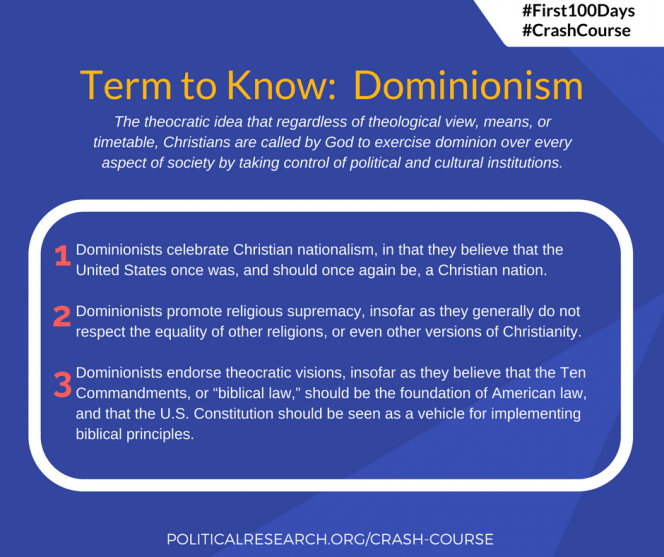
Week 4: Fascism, Authoritarianism, Right-Wing Populism
Fascism and neofascism: Fascism is an especially virulent form of far-right populism. Fascism glorifies national, racial, or cultural unity and collective rebirth while seeking to purge imagined enemies, and attacks both revolutionary movements and liberal pluralism in favor of militarized, totalitarian mass politics. Fascism first crystallized in Europe in response to the Bolshevik Revolution and the devastation of World War I, and then spread to other parts of the world. If it is a post-WWII occurrence it should be called neofascist or neofascism unless it solely involves participants in older movements. Neofascists reinterpret fascist ideology and strategy in various ways to fit new circumstances.
Right-wing populist movements target superficial or false symbols of elite power, reinforces systems of social privilege and oppression, and is built around a backlash against liberation movements, social reform, or revolution. Right-wing populist movements feed partly on people’s grievances against their own oppression but deflect that anger away from positive social change. Right-wing populism is a form of repressive populism.
Featured resources:
- ‘Trumping’ Democracy: Right-Wing Populism, Fascism, and the Case for Action by Chip Berlet
- What time is it?: Why we can’t ignore the momentum of the Right by Scot Nakagawa and Tarso Luís Ramos
- What is Fascism? By Matthew N. Lyons
- “What is Right-Wing Populism?” by Spencer Sunshine, excerpted from Up in Arms: A Guide to Oregon’s Patriot Movement
Additional Readings:
- See our Fascism Portal Page!
- Explore the website based on the book Right-Wing Populism in America: Too Close for Comfort by Chip Berlet and Matthew N. Lyons
Week 5: Neoliberalism and Privatization
Featured Excerpt: “From the New Right to Neoliberalism: the Threat to Democracy Has Grown” by Jean Hardisty
Neoliberalism can be a difficult concept for most progressives, who may incorrectly understand it as a watered-down version of New Deal liberalism—in other words, part of the platform of the current Democratic Party. But that is not what neoliberalism is. Because neoliberalism best captures the shift we are seeing in the U.S., it is crucial that we understand its actual meaning.
Neoliberalism is the economic, social, and political analysis that best describes the startlingly unequal distribution of wealth and power in the U.S. today. Neoliberalism, and the policies it undergirds, results from the triumph of capitalism and is sometimes called “late-stage capitalism” or “super-capitalism.”
The roots of neoliberalism lie not primarily with the New Deal but in the years immediately after World War II, when a group of U.S. and European economists met to discuss how to prevent another Holocaust. They concluded that the only protection against dictatorship, fascism, or rule by military junta was individual freedom, which only a weak government and unfettered, free-market capitalism could preserve. As pure theory, this describes “classical liberalism,” best formulated by 17th-century English philosopher John Locke and 19th-century British philosopher John Stuart Mill. But, in practice, neoliberalism takes this theory to extremes. Unlike neoliberalism, classical liberalism neither explicitly opposes democratic principles nor seeks to replace democracy with oligarchy.
A leading U.S. participant in the post-war economic think tank was University of Chicago economist Milton Friedman, who received intellectual guidance from group members Friedrich von Hayek, of Germany, and Ludwig von Mises, of Austria. They founded the Mont Pélerin Society, which convened neoliberal leaders to discuss strategy and which continues to meet today. Friedman’s ideas became the guiding principles of U.S. neoconservatives, driving the economic “reforms” of the Reagan administration.2 These morally conservative former Democrats switched parties and embraced a “new” conservatism that sidelined blatant racism and anti-Semitism, and touted free-market capitalism.
Later in the 20th century, leftist scholars from emerging countries (and some wealthy ones) adopted the term “neoliberalism” as a pejorative to capture the policies of exploitation, privatization, and inequality imposed on them by the U.S. and other economic superpowers. This was done through trade agreements, and by the policies of the International Monetary Fund and the World Bank. Leftist U.S. scholars – perhaps most prominently, Noam Chomsky – adapted the term to describe the co-optation of economic and political institutions of developing nations.
Neoliberalism became characterized by the use of international loans and other mechanisms to suppress unions, squelch regulation, elevate corporate privilege, privatize public services, and protect the holdings of the wealthy. As U.S.-backed policies and puppet politicians were labelled “neoliberal” by scholars, the term became widely-recognized shorthand for rule by the rich and the imposition of limits on democracy.3
Neoliberalism has now come home to roost, with the people of the U.S. subject to its policies and goals. Here in the United States, we are increasingly not a democracy but a country ruled by an oligarchy. Neoliberals most often exercise power in the U.S. not by working through the International Monetary Fund, the World Trade Organization, or the World Bank, but rather by shifting rule from the people to corporations. Voting rights, reproductive rights, the right to a fair and just legal system, a strong and effective safety net for the poor, and even the right to a secular state are all under attack.
Additional readings:
- Midterm Elections: School Privatization Continues to Advance DeVos/Heritage Foundation Strategy by Rachel Tabachnick
- From the New Right to Neoliberalism: the Threat to Democracy Has Grown by Jean Hardisty
- Privatizing Massachusetts: The Right-Wing’s Blue State Game Plan by Abby Scher
- Globalization and NAFTA Caused Migration from Mexico by David Bacon
- Neoliberalism, Higher Education, and the Rise of Contingent Faculty Labor by Jason Del Gandio
- To Shock the Heart of the Nation: Interview with Rev. Dr. William Barber II by Mariya Strauss
Week 6: Racism and White Supremacy
White supremacy is a term is used in various ways to describe a set of beliefs; organized White hate groups; or a system of racial oppression that benefits White people. As an ideology, it is the belief that the socially constructed “White race” is superior to other “races.” As a system, White supremacy in the U.S. is maintained when White people defend, deny, or ignore the reality of the continued systematic subordination and oppression of people of color. White supremacy is the most powerful form of racism in the US, and it has two major forms: racism by Whites used to justify the oppression of people of color; and the racialized construct of antisemitism in which Jews are falsely claimed to be a distinct non-White race, and are then deemed a sinister race.
Racial inequality remains deeply embedded within U.S. social and economic structures, even as its forms and justifications are in flux. Claims to White racial superiority, though not entirely dead, were largely washed aside by the civil rights struggles of the ’50s and ’60s. Since that time, so-called “colorblind” racism has become the dominant racial ideology in the United States. Opposition to affirmative action, indigenous treaty rights, and other government programs is commonly justified with the claim that equal rights among racial groups have been achieved and that we as a society are, or should be, “beyond race.” This belief in the diminishing importance of race makes it more, not less, likely that stark racial inequalities will persist since they will remain unchallenged.
To bolster their colorblind rhetoric, some sectors of the Right promote spokespeople – and provide patronage to conservative intellectuals and institutions – from communities of color. Growing immigration, especially from Latin America and Asia, threatens Whites’ numerical majority, and, along with the government’s massive post-911 campaign of racial profiling, is inspiring a nativist and White supremacist backlash. Anti-Semitic conspiracy theories have also experienced resurgence since the 911 attacks.
Featured resources:
- How Colorblindness Co-Evolved with Free-Market Thinking by Michael Omi & Howard Winant
- Terror Network or Lone Wolf: Disparate Legal Treatment of Muslims and the Radical Right by Naomi Braine
- 35 Years of Demonization: The Criminalization of Black Women By Victoria Law
- 5 Right-Wing Media Narratives Attacking the ‘Black Lives Matter’ Movement by Spencer Sunshine
Media:
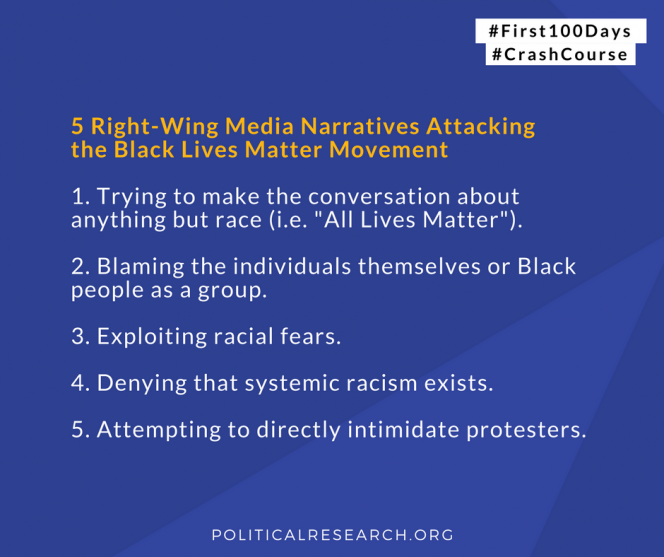
Week 7: Misogyny
Male supremacism, enshrined in the nation’s founding documents, is as fundamental to U.S. history as White Anglo-Saxon Protestant (WASP) nativism. The same patriarchal stance—combining race, religion, and nativism—fuels conservative Christian ideology on appropriate gender roles. (Transgender women and men and genderqueer individuals also violate these designated roles.) Especially in the last 100 years, as some women have succeeded in pushing back against the sexist world they inherited, social and political movements have emerged to defend traditional gender structures.
Featured resource:
- Mobilizing Misogyny by Alex DiBranco
Additional resources:
- Ctrl-Alt-Delete: The origins and ideology of the Alternative Right Report by Matthew N. Lyons
- 35 Years of Demonization: The Criminalization of Black Women By Victoria Law
- Neoliberal Feminists Don’t Want Women to Organize by Sarah Jaffe
Week 8: Bigotry and ethnoviolence
Whether it’s a spree killing, a vandalized mosque, or a bias attack on a queer teen, Americans are quick to chalk it up to hate. The label “hate crime” invites us to blame overwrought individuals acting on extreme personal prejudice, making it seem as if a small cadre of social deviants is our main obstacle to a peaceful society. In fact, such individuals are products of a society that endorses all kinds of violence against the very same groups who are targeted in hate crimes. The perpetrators of these crimes are taking their cues from a society that embraces mass incarceration, militarized policing, the school-to-prison pipeline, and other forms of structural violence wielded disproportionately against people of color, queer and trans or gender non-conforming people, and the poor.
Featured resources:
- Beyond the Hate Frame: An Interview with Kay Whitlock & Michael Bronskiby Lindsay Beyerstein
- Reconsidering Hate: Policy and Politics at the Intersection by Kay Whitlock
- Pro-LGBTQ Smokescreens for Anti-Muslim Attacks by Cole Parke
- The Internet Protocols of the Elders of Zion by Emma Grey Ellis
Week 9: LGBTQ RIGHTS
Opposition to LGBTQ equality has long been both a fundamental value and useful political tool for many American conservative organizations, especially those associated with the Christian Right. Even as visibility and mainstream acceptance of LGBTQ people grows, homophobia and transphobia continue to serve as key ingredients in the Christian Right’s ongoing “pro-family” campaign, which enforces a Biblically mandated heterosexuality, champions gender essentialism or “complementarity,” and prioritizes procreation.
Featured resources:
- A Dystrumpian Vision for LGBTQ People by Frederick Clarkson and Scot Nakagawa
- The Christian Right on the Gender Frontier: The Growing Anti-Trans Offensive by Cole Parke
- The Christian Right’s Love Affair with Anti-Trans Feminists By Cole Parke
- Resisting the Rainbow: Right-Wing Responses to LGBT Gains edited by Pam Chamberlain
Additional Readings:
- See our LGBTQ Rights Portal Page!
Media:
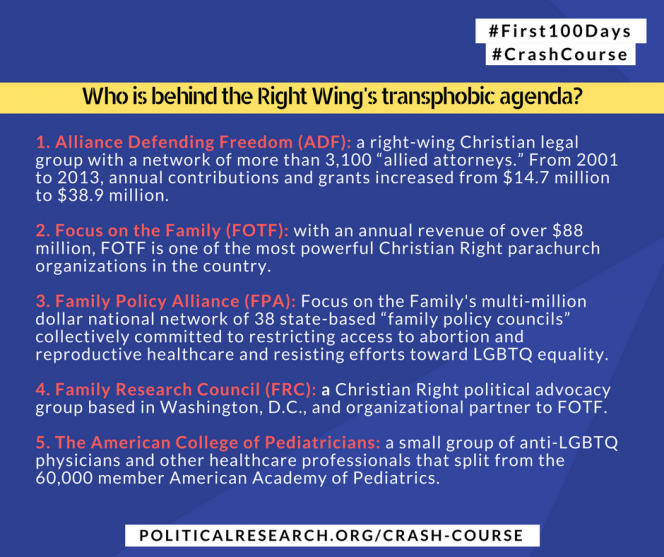
Week 10: Economic justice
What would our democracy look like without the influence of corporations and industrialists? It has become nearly impossible to imagine an answer to this question. As the late political scientist Jean Hardisty wrote in 2014, neoliberalism—or deregulated market capitalism—”seeks to replace democracy with oligarchy”. Indeed, corporate money and influence are remaking our democratic institutions, from the dark-money lobbying groups and think tanks pushing limitless deregulation, to individual wealthy donors putting their thumbs on the scales of public policy in state legislatures and using new Voter ID laws to suppress the vote. As progressives contemplate how to build a movement for justice that can effectively counter such forces, it is necessary to understand how the Corporate Right—what we might term the Chamber of Commerce wing of the conservative movement—is collaborating with others on the Right to advance its agenda.
Featured resources:
- From the New Right to Neoliberalism: The Threat to Democracy Has Grown by Jean Hardisty
- “Faith-Washing” Right-Wing Economics: How the Right is Marketing Medicare’s Demise by Mariya Strauss
- Dark Money, Dirty War: The Corporate Crusade Against Low-Wage Workers by Mariya Strauss
- The Religious Right Has Been Pushing Anti-Union Right to Work Laws for A Century by Mariya Strauss
Week 11: Reproductive justice
The more recent trend in anti-reproductive justice attacks is a state-by-state approach designed to gradually chip away at existing rights. According to the Guttmacher Institute, in the 40+ years since Roe v. Wade, states have enacted over 1,000 abortion restrictions. These laws and policies have expanded requirements for parental involvement and abortion counseling, and apply limits to medication abortions, later abortions, and coverage requirements from private insurance companies. Other strategies, such as the Prenatal Nondiscrimination Act (PRENDA), effectively manipulate the language of equality and exploit negative stereotypes about women of color in order to advance their agenda. Additionally, the Right’s redefinition of religious liberty — as exemplified in the Supreme Court’s Hobby Lobby ruling — represents a serious threat to reproductive justice and civil liberties more broadly.
Featured resources:
- Defending Reproductive Justice Activist Resource Kit
- Whole Woman’s Health’s Unexpected Win for Science by Alex DiBranco
- How the Right is Co-Opting #BlackLivesMatter to Roll Back Repro Rights by Cole Parke
- When Exemption is the Rule: The Religious Freedom Strategy of the Christian Right by Frederick Clarkson
- Abortion as “Black Genocide”: An Old Scare Tactic Re-emerges by Kathryn Joyce
Week 12: Public Education
From “school choice” schemes and the neoliberal privatization movement to the influence of the Christian Right on curriculum and school policy, public education is a key battleground.
Featured resources:
- Defending Public Education – Activist Resource Kit
- Opening Pandora’s Box: The Rise & Fall of the Right’s School Voucher Pioneer by Rachel Tabachnick
- Alliance Defending Freedom: the Right-Wing Lawyers Fueling Transphobia in Schools by Cole Parke and Gabriel Joffe
- The Right’s “School Choice” Scheme By Rachel Tabachnick
- From Schoolhouse to Statehouse: Curriculum from a Christian Nationalist Worldview by Rachel Tabachnick
Additional resources:
- Privatizing Massachusetts: The Right-Wing’s Blue State Game Plan by Abby Scher
- History Wars Exposed: Right-Wing Influence in APUSH Curriculum Update by Gabriel Joffe and Katherine Stewart
- From Singapore to Arizona: Right-Wing Groups Invade Classrooms and Curriculum by Cole Parke
- “Zero Tolerance” for Silenced Histories: Neglecting Civil Rights Education in Schools by Rebecca Suldan
- The Koch-Like Family You’ve Never Heard Of Influencing State Legislatures by Jonathon Orta
Week 13: Political Repression, Surveillance, and Prisons
The steady expansion of both the power and use of law enforcement in multiple areas of life reflects (and institutionalizes) right-wing worldviews regardless of the political party or identity claims of the speaker. These readings explore the intersections between the War on Drugs and the War on Terror, Neoliberalism and prison reform, and race and surveillance.
Featured resources:
- Crime Control & Political Repression: From the War on Drugs to the War on Terror by Naomi Braine
- Intelligence Fusion Centers: A De-centralized National Intelligence Agency by Thomas Cincotta
- Tracking Blackness: A Q&A with Dark Matters Author Simone Browne by Lindsay Beyerstein
- Beyond Prisons, Mental Health Clinics: When Austerity Opens Cages, Where Do the Services Go? by Liat Ben-Moshe and Erica R. Meiners
Week 14: Exportation of U.S. Culture Wars
From politicians to preachers, the work of the U.S. Right has far-reaching consequences. These readings will examine the role of the U.S. Christian Right in the exportation of American culture wars. We begin with Rev. Dr. Kapya Kaoma’s groundbreaking 2009 report, which documents how U.S. conservative evangelicals are promoting an agenda in Africa that aims to criminalize LGBTQI people.
Featured resources:
- Globalizing the Culture Wars: U.S. Conservatives, African Churches, and Homophobia by Kapya Kaoma
- Natural Deception: Conned By the World Congress of Families by Cole Parke
- East vs. West? Russia, Ukraine, and the Anti-Gay Wedge by Cole Parke
- International Backlash: The Religious Right at the UN by Peter Montgomery
- Franklin Graham: Falwell Prodigy, Putin Lover, and Trump Fan by Cole Parke
